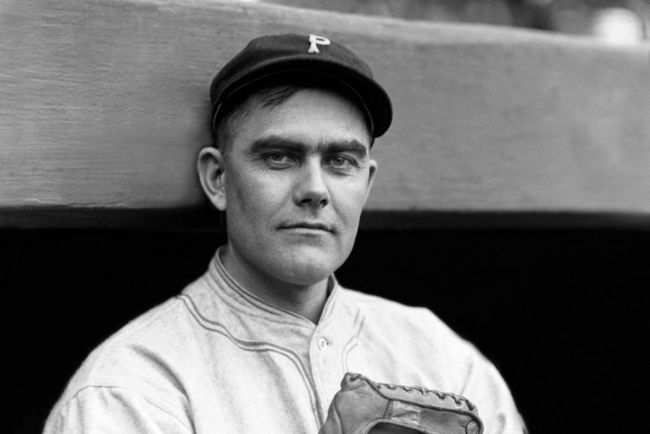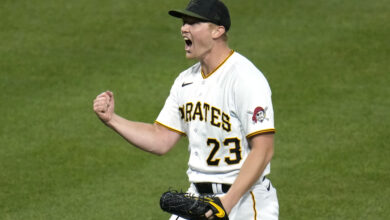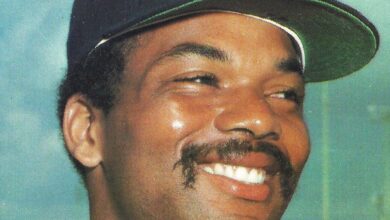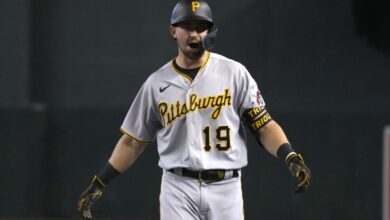
Although nobody under 40 would recall much of it, the Pittsburgh Pirates have had a rich history. Many all-time greats have worn the Pirates uniform. The Pirates have retired nine numbers: players Ralph Kiner (4), Willie Stargell (8), Bill Mazeroski (9), Paul Waner (11), Pie Traynor (20) Roberto Clemente (21) and Honus Wagner (33) and managers Billy Meyer (1) and Danny Murtaugh (40).
However, that list only scratches the surface. Have you ever tried to make up an all-time Pirates all-star team, excluding players who have had their numbers retired? As a public service, I’ve saved you the trouble and done just that. It’s a fascinating way to learn some baseball history. Some of the players I chose may have had their numbers retired, had they not played in an era before uniforms had numbers. The number retired for Wagner was his number as a coach.
Many players were carefully considered and compared on elaborate spreadsheets weeks in the making. I’ll have to delete them before the kids find them. Surely they’ll use them as evidence at the insanity hearing 20 years from now. But now, let’s get to the choices. After each player’s name, I’ve indicated the years played for Pittsburgh and his statistics with the Alleghenys and Pirates.
Starting pitcher
Babe Adams (1907-1926; 194-139, 2.74 ERA, 205 CG, 1.09 WHIP).”Far above all others on the tablet of baseball fame, marking the highest point ever reached in individual brilliancy and outshining the greatest previous achievements in the annals of the Nation’s sport, must be written to-day [sic] in large and blazing capitals the name of ADAMS,” trumpeted the October 17, 1909 Pittsburgh Daily Post after the Pirates won the World Series in seven games over the Detroit Tigers. In a Series highlighted as a matchup between the great Wagner and Ty Cobb, it was Adams, 27, who stole the show. He won all three of his Series starts, surrendering four earned runs in three complete games. The mighty Cobb was only 1-for-11 against Adams.
Of course, the 1909 World Series wasn’t the only reason for choosing Adams. In 18 years for Pittsburgh, he won at least 17 games five times. He was 22-12 in 1911 and 21-10 in 1913. He had the best WHIP in the National League five times and the best strikeout/walk ratio four times.
A strong argument could be made for Deacon Phillippe (1900-1911; 168-92; 2.50 ERA) over Adams. I would counter by saying Adams did it longer and excelled on the big stage, also noting Phillippe had a stronger team behind him.
Catcher
Manny Sanguillen (1967-1976, 1978-1980; .299/.329/.403, 59 HR, 527 RBIs). Sanguillen was a three-time All-Star at a time when the Pirates regularly sent several representatives to the All-Star Game. In his day, he was considered the second-best catcher in baseball behind Johnny Bench. After the 1976 season, he was traded to Oakland for manager Chuck Tanner. The Pirates would reacquire Sanguillen in time for the 1978 season. From then on, he was mostly a used as a pinch hitter and reserve first baseman. His last hurrah as a Pirate was his ninth-inning, game-winning pinch-hit single in the second game of the 1979 World Series in Baltimore. Today he can be found at Manny’s BBQ behind the outfield stands at PNC Park, his knees heavily wrapped with ice packs, hawking hamburgers and pulled pork sandwiches and signing autographs. He’ll tell you he was better than Bench, too.
First baseman
Gus Suhr (1930-1939; .278/.366/.427, 79 HR, 789 RBIs). Suhr was a steady performer who drove in more than 100 runs three times as a Pirate. A good fielder, he played in 822 consecutive games from 1931-1937, a National League record that stood until 1957. It’s still a Pirates team record. Exit velocity wasn’t measured in his time, but contemporary accounts say he hit the ball hard.
The choice of Suhr over Jake Beckley (1888-1889, 1891-1896; .300/.359/.442, 43 HR, 664 RBIs) here may raise some eyebrows. After all, Beckley is in both the National Baseball and Pirates Halls of Fame; Suhr is in neither. However, I’ll take Suhr, the reliable “Iron Man” who had more power.
Second baseman
George Grantham (1925-1931; .315/.410/.491, 74 HR, 508 RBIs). Grantham hit at least .305 in all seven seasons as a Pirate. The Pittsburgh Sun-Telegraph described him as an “erratic fielder” yet a fan favorite. There were years where he was primarily a second baseman. There were other years where he was primarily a first baseman. Although Grantham stole only 58 bases as a Pirate, in 1953 an old fan told Al Abrams of the Pittsburgh Post-Gazette, “George was a running fool and was a half step faster than the rest of the Pirates in getting to first. The entire team, made up of fast men, was inspired by Grantham. They ran the opposition dizzy.”
Shortstop
Arky Vaughan (1932-1941; .324/.415/.472, 84 HR, 764 RBIs). Vaughan hit at least .300 in all 10 seasons as a Pirate, making the All-Star team in the last eight. He won the league batting title in 1935 when he hit .385. He led the league in OBP three straight years from 1934-1936. Vaughan also led the league in several offensive categories at different times during his Pirates career. Fun fact: Only three shortstops have won National League batting titles and all three were Pirates — Wagner, Vaughan and Dick Groat.
Third baseman
Tommy Leach (1900-1912, 1918; .271/.332/.373; 43 HR, 625 RBIs, 271 SB) “A beautiful ballplayer to watch,” said Wahoo Sam Crawford to Lawrence Ritter in The Glory of Their Times. Listed at 5’6” and what’s believed to be a generous 150 pounds, Leach was known for his blazing speed. In 1902, he led the league in home runs with six(!) and triples with 22. Most of his homers were of the inside-the-park variety. Due to his diminutive stature, opposing outfielders played shallow against him. Leach sometimes drove the ball between them and scampered around the bases before they could retrieve it. As a Pirate, he finished in the top 10 in the league in homers five times, never hitting more than seven in a season, and in “position player” WAR four times, although in his day, nobody knew what that was. Like many star players of his era, he filled in at other positions when needed. By 1909, he was the Pirates’ regular center fielder.
Yes, I know Bill Madlock (1979-85; .297/.357/.428, 68 HR, 390 RBIs) won two batting titles as a Pirate. To some, he might seem the logical choice here. However, he became a malcontent and tanked in 1984 and 1985, forcing a trade to the Dodgers. That disqualifies him in my book.
Left fielder
Barry Bonds (1986-1992; .275/.380/.503, 176 HR, 556 RBIs, 251 SB). As you know, his major-league career is marred with allegations of PED use during his time with the Giants. However, there were no such suspicions clouding his Pirates career. I wasn’t thrilled with some things I’d heard about Bonds as far as how he treated people. However, this is an all-star team, not an all-Emily Post team. His throwing arm was suspect, but otherwise Bonds was blessed with all the tools needed to succeed in baseball. He was an All-Star and won the league MVP Award in 1990 and 1992. He also won the Gold Glove and Silver Slugger Awards in 1990-1992. Due to his postseason failures and openly stated desire to leave Pittsburgh when he became a free agent, he remains a polarizing figure among Pirates fans.
Center fielder
Lloyd Waner (1927-1941, 1944-1945; .319/.356/.399, 27 HR, 577 RBIs). I realize he played in an era of higher batting averages. Even so, some of the averages he put up are crazy: .355 in 1927, .353 in 1929 and .362 in 1930. He played alongside his brother, right fielder Paul Waner, for many years. Suhr told me in a 1998 letter, dictated to his daughter, “The Waners were great ball players, especially Paul. They both were excellent fielders with good arms.” How the Pirates could have the Waner brothers, Suhr, Traynor and Vaughan on the same team for so many years and not win a pennant is one of the great mysteries of the universe.
Right fielder
Dave Parker (1973-1983; .305/.353/.494, 166 HR, 758 RBIs, 123 SB). He was the best player in baseball from 1975-1979. With a rifle of a throwing arm runners tested at their own peril, Parker was more gifted than Bonds. But while Bonds was graceful, Parker played baseball like a bat out of hell. He ran over catchers and crashed into outfield walls, beating up his body to the point where it affected his numbers in later years. As a Pirate, he won batting titles in 1977 and 1978 and an MVP award in 1978. For his two outfield assists, he was MVP of the 1979 All-Star Game. He was booed out of Pittsburgh for daring to make $1 million per year for playing baseball. When I hear today’s Pittsburgh fans moaning about the owner not spending enough money on players, it’s hard to believe it’s the same town.
Designated hitter
Andrew McCutchen (2009-2017, 2023; .289/.379/.482, 213 HR, 755 RBIs, 181 SB as of August 7). “Cutch” is the only guy who can be considered a Pirates’ regular designated hitter since the National League permanently adopted the rule last year. Still, he’s worthy of this team and was a strong candidate for its center field spot. Another naturally gifted five-tool player, McCutchen was the 2013 MVP and an All-Star from 2011-2015. More importantly, he’s the face of the 2013-2015 Wild Card teams that ended a 20-year losing streak for the Pirates. His number will surely be among the Pirates’ retired numbers when his career is over. With players not staying as long on one team anymore, Cutch’s 22 could well be the next and last number the Pirates retire.
Relief pitcher
Roy Face (1953-1968; 100-93, 3.46 ERA, 186 saves). Teammates will tell you he belongs in the Hall of Fame. Although not yet an official stat, Face led the league in saves three times. He was also a six-time All-Star from 1959-1961. You read that right. There were two All-Star Games a year in those years. We’ll probably never see another season by a reliever like 1959, when Face was 18-1 out of the bullpen. Face saved 24 games for the 1960 World Series champs. Still kicking at age 95, I doubt he’s ever had to pay for a meal or drink in Pittsburgh since.
Manager
Fred Clarke (1900-1915; 1,422-969). Clarke was a player/manager, patrolling left field, mostly hitting behind Wagner, batting .299/.379/.418, 33 HR, 622 RBIs with 261 SB. He and Frank Chance are the only guys in the Hall of Fame worthy of induction as either player or manager. Clarke’s team lost to the Boston Americans in the 1903 World Series, the first ever played. But his teams also won three championships. Besides winning the 1909 World Series, they won National League pennants in 1901 and 1902. Like the Pittsburgh Pipers’ 1968 ABA championship, the 1901 and 1902 titles are overlooked because there was a rival league that had its own champion. But in each of these three cases, the team got as far as it could in a major league. To me, these are legitimate championships. Clarke also invented and held the patent for the flip-down sunglasses in use by major-league outfielders to this day.
Of his managerial style, before the 1910 season, Clarke told journalist Joseph B. Bowles, “My players think I am something of a crank on discipline, and on keeping in condition. Perhaps that is so. I believe in careful training in the spring, and still more careful training and conditioning during the entire season … I think cigarettes are the worst things possible for a player, both for his wind and for his eyes. If a player takes a drink of ale or beer, he ought to do it after a hard game, or when he feels himself in danger of going stale.”





